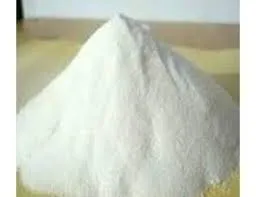
अक्ट . 12, 2024 18:19 Back to list
Exploring the Benefits and Applications of Redispersible Polymer Powders in Construction Materials
Understanding Redispersible Polymer Powders and Their Applications
Redispersible polymer powders (RDPs) are widely recognized in the construction and building materials industries for enhancing the performance and properties of dry mix formulations. These powders represent a significant advancement in material technology, allowing for improved adhesion, flexibility, water resistance, and overall durability of various construction products.
What are Redispersible Polymer Powders?
RDPs are synthetic polymers that are produced in a powder form through a process of spray-drying emulsions. When mixed with water, these powders redissolve to form a stable dispersion, which can then be incorporated into cementitious or gypsum-based systems. Common types of RDPs include ethylene-vinyl acetate (EVA), styrene-acrylic copolymers, and polyvinyl acetate (PVA). Their ability to be re-dispersed makes them particularly useful for dry mix formulations, enabling manufacturers to achieve desired performance characteristics without the complications associated with liquid additives.
Key Benefits of RDPs
1. Improved Bonding and Adhesion One of the primary advantages of incorporating RDPs into mortars and adhesives is the enhancement of bonding strength. RDPs create a cohesive film that improves adhesion to various substrates, making them ideal for tile adhesives, plaster, and repair mortars.
2. Flexibility and Elasticity RDPs contribute to the flexibility of cement-based products, allowing them to accommodate structural movements and thermal expansions without cracking. This characteristic is essential for applications in areas subjected to vibrations or temperature fluctuations.
3. Water Resistance The water-repellent properties imparted by RDPs improve the long-term durability of construction materials. This feature is particularly valuable in external applications, such as façade systems and roof coatings, where exposure to moisture can lead to degradation.
4. Enhanced Workability RDPs improve the workability of cementitious mixes, allowing for smoother application and leveling. This is vital in ensuring user-friendliness for contractors and builders.
redispersible polymer

5. Reduced Shrinkage and Cracking By modifying the rheological properties of the mixture, RDPs help mitigate the risks of shrinkage and cracking, which can adversely affect the integrity of finished structures.
Applications in the Construction Industry
RDPs find numerous applications in the construction sector, including but not limited to
- Tile Adhesives RDPs ensure strong bonding between tiles and substrates, accommodating movements and preventing delamination. - Render and Plaster Incorporating RDPs improves flexibility and adhesion, making renders and plasters more resilient against delamination and cracking.
- Self-Leveling Compounds RDPs enhance the flow characteristics of self-leveling compounds, ensuring even distribution and stable curing
.- Repair Mortars For repairing damaged structures, RDPs provide the necessary strength and flexibility to withstand environmental stresses.
Conclusion
The introduction of redispersible polymer powders has revolutionized the construction materials industry, offering solutions that enhance the performance and longevity of building products. As the demand for high-quality and durable construction materials grows, RDPs play a vital role in meeting these needs. Their ability to improve adhesion, flexibility, and overall performance makes them an indispensable component in modern construction applications.
As research and development continue in this field, we can anticipate even more innovative uses and formulations, further solidifying the place of redispersible polymer powders as crucial contributors to the construction industry's evolving landscape. Whether for residential, commercial, or infrastructure projects, RDPs will undoubtedly remain at the forefront of building material technology, ensuring structures are not only built to last but are also sustainable and resilient.
-
Unlocking the Benefits of HPMC Products: A Gateway to Versatile Applications
NewsAug.07,2025
-
Unleashing the Potential of HPMC Ashland: A Comprehensive Look
NewsAug.07,2025
-
Tile Bonding Cellulose: The Key to Superior Adhesion and Durability
NewsAug.07,2025
-
Hydroxypropyl Methylcellulose Powder: The Versatile Component in Modern Pharmaceuticals
NewsAug.07,2025
-
Hydroxyethyl Cellulose: The Versatile Solution for Various Industries
NewsAug.07,2025
-
Hydroxyethyl Cellulose (HEC): The Versatile Polymer for Various Applications
NewsAug.07,2025







